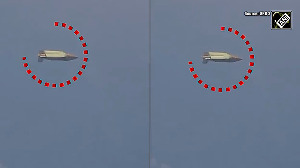It always helps to be part of a rich and powerful lineage. That should explain why the newly born Reliance Petroleum, subsidiary of the country's largest private enterprise Reliance Industries, comes with a price tag of Rs 27,000 crore (Rs 270 billion) even before it has laid the foundation stone.
What the company does have is a grand plan, which if executed successfully, has potential to deliver 50-100 per cent returns in five years. With a parent known for its project management skills, a favourable market for refining products and the benevolence of the government (read tax breaks for SEZs), RPL could emerge as a clear winner.
But like in any start-up, RPL faces the risk associated with time over-runs, which becomes critical as a chunk of industry expansions announced thus far would probably come on stream close to 2012.
RPL is coming out with an initial public offer of 180 crore (1.8 billion) shares in the band of Rs 56-62. Half of the issue would be subscribed by Reliance Industries at the higher end of the band. Of the other half, 45 crore shares have already been picked up by promoter Mukesh Ambani and institutional investors at Rs 60. The rest is being offered to the public.
For the record, Reliance Industries had invested Rs 2,700 crore (Rs 27 billion) in RPL as equity in three tranches over December 2005, January and February 2006. The shares were issued at par.
Taking together the money raised through the public issue, including pre-IPO placement and all subscriptions by RIL, the company would have a net worth of Rs 16,200 crore (Rs 162 billion).
This would part-fund its Rs 27,000 crore (Rs 270 billion) refinery at Jamnagar in Gujarat, adjacent to its existing refinery. The balance amount would be funded through debt, which has been partly tied up with banks and institutions.
The 100 per cent export-oriented refinery will have a capacity of 580 kilo barrels a day, making it the 6th largest global refinery. Currently, RIL has a crude throughput of 660 kbpd.
RPL is also setting up a 900,000 tonne per annum polypropylene plant in the SEZ.
But the proposed refinery is likely to beat the existing refinery, thanks to its higher level of complexity, which will earn RPL higher gross refining margins (the difference between cost of crude and the selling price of refined products).
The quality of crude oil and other feedstocks dictates the level of processing and conversion necessary to achieve an optimal mix of finished products.
Over the years, the mix of crude oil grades available worldwide has changed with a general increase in availability of heavy and sour crude oils relative to light and sweet crude oils.
Light sweet crude oils are more expensive than heavier and sourer crude oils because they require less treatment and produce a slate of products with greater percentage of value-added products such as gasoline, aviation fuel and diesel.
| WHAT'S IN STORE | ||
| Number of shares |
Amount raised (Rs cr) | |
| RIL @ Rs 10 | 270 | 2,700 |
| Public @ Rs 62 | 45 | 2,700 |
| RIL @ Rs 62 | 90 | 8,100 |
| Pre-placement @ Rs 60 | 45 | 2,700 |
| Total equity | 450 | 16,200 |
| Debt | 11,000 | |
| M-cap @ Rs 62 | 27,900 | |
| Enterprise value | 38,900 | |
| Ebitda FY10e | 7,100 | |
| EV @ 7.5x EV/Ebitda multiple | 53,250 | |
| Market-cap FY10e | 42,250 | |
| Appreciation (%) | 44.26 | |
| EV @ 8.5x EV/Ebitda multiple | 60,350 | |
| Market-cap FY10e | 49,350 | |
| Appreciation (%) | 76.88 | |
On the product side, again, demand for light and middle distillates has increased, including fresh demand for products that meet stricter environmental standards, driving up prices for light and middle distillates. A combination of these market factors has resulted in an increasing light heavy differential.
Thus, complex refineries that are able to convert heavy crude oils into light products can achieve significantly higher GRMs than simple refineries.
In fact, shortages of complex refining capacity itself could increase the price differential between light and heavy crude. Since crude oil typically accounts for 90-95 per cent of the total cost of refining, ability to process cheaper crude substantially boosts margins.
Over the last three years, the price differentials between WTI and Dubai (the sour variety with higher sulphur content) have widened.
While the majority of the crude oils processed by RIL is linked to Dubai, realisations for the petroleum products exported to the markets, where WTI and Dated Brent are the feedstock price benchmarks, have improved as a result of widening spreads. The widening spread will mean that the new refinery can better existing RIL margins owing to higher complexity.
Measured in terms of Nelson Complexity index, the RPL refinery will have a complexity of 14.0 against RIL's 11.0. The average API of crude required for the new refinery is 24 compared with 28 for RIL. API gravity is a measure of density of petroleum liquids and higher the API gravity, the lighter is the crude oil.
Translated, this means the new refinery would be able to process heavy crude with high sulphur content. The existing RIL refinery at Jamnagar has consistently commanded a premium of $2.5-3 over the Singapore Refining margins, the benchmark for refiners in the region.
Analysts estimate gross refining margins to be at least $10 a barrel, assuming that the regional margins would settle around $5 and RPL would command a premium for its complexity.
The big picture looks good. Although the number of refineries in Europe and the US have significantly decreased from the peaks of 1978 and 1981, respectively, the world's refining capacity has remained approximately at the same level as it was in the early 1980s.
Besides, tightening petroleum product specifications are likely to result in further closure of low complexity and low economic size refineries. Currently, the world refining capacity is about 85 mmbd.
Also, nearly 40 per cent of the world's crude distillation capacity is more than 25 years old and cannot be overhauled to meet the new requirements. Even as more than 100 refining projects have been announced, aggregating about 22 mmbd, Reliance officials say their interactions in the global markets indicate that not more than 4.5 mmbd of these projects would take shape by 2010.
More importantly, analysts say that setting up a large-scale project would take a lead time of 48-60 months and, thus far, not too many firms, which announced the expansion, have tied up with vendors.
On the contrary, Reliance, relying on its experience, has charted out an ambitious target of completing the project and starting commercial production by December 2008. The company has already entered into agreements with Bechtel France to license the technology for major process units of the refinery and polypropylene plant.
Interestingly, the company plans to set up the refinery at a capital cost of $6 billion, nearly 40 per cent lower to the industry average.
A similar-sized refinery at an average $42 a barrel of CDU capacity would mean a cost of $10.4 billion, according to company estimates.
To put this in perspective, over 20 years, the company would process about 4.2 billion barrels of crude. Amortising $4 billion over 4.2 billion barrels of crude results in a saving of 1 dollar per barrel, says a Reliance official.
Even as the company would utilise the capabilities of its parent, dealing with related parties raises concerns.
For instance, the use of infrastructure services such as power, port terminals are to be provided by promoter's privately owned companies RPTL and RUPL. Besides, another family owned company REAL is supposed to be provide civil construction at competitive prices. There isn't much clarity on the actual commercial agreement between these companies.
Since the refinery is proposed to be set up in a special economic zone, the company is entitled to deduction of 100 per cent the profits and gains from exports for five years after commercial production begins, and 50 per cent deduction for another five years. This again would lead to better post-tax returns.
Reliance expects that given the current demand-supply situation, refining margins would be firm and the window of opportunity between the beginning of commercial products in its new facility and the next round of industry expansion would be good enough to ensure a pay-back period of less than four years.
Ability to meet stringent environmental norms, including ultra-low sulphur diesel for sophisticated markets of the US and Europe would enhance profitability.
Besides, with the refinery being close to West Asia, the largest crude oil-producing region, the company expects this to result in lower ship turnaround time and freight costs.
Considering the advantage arising out of the company's aggressive implementation schedule, before competing capacities catch up, analysts estimate GRMs are 10.4/bbl in FY10, gradually tending downwards to $7-7.5 in the long term.
Since the company has roped in investors at higher valuations, and debt levels would probably be around Rs 11,000 crore (Rs 110 billion), this would result in substantial interest cost savings. Operating profit could thus be around Rs 7,100 crore (Rs 71 billion) and net profit upwards of Rs 5,000 crore (Rs 50 billion) in FY10.
Assuming the company would command a Enterprise Value/Ebitda multiple of 7.5x, RPL would have a market-cap of Rs 42,250 crore (Rs 422.5 billion), which would translate into an appreciation of 44 per cent from the higher end of the price band. The gains could vary depending on the multiple and the actual cash flows.
Since markets are buoyant right now, Reliance Petroleum should provide listing gains. However, there is a reasonable chance that one would get a buying opportunity at lower levels over the next three years especially if the market sees a correction.
At current valuations, investors need to take a really large leap of faith in the management.Do you want to discuss stock tips? Do you know a hot one? Join the Stock Market Investments Discussion Group








 © 2025
© 2025